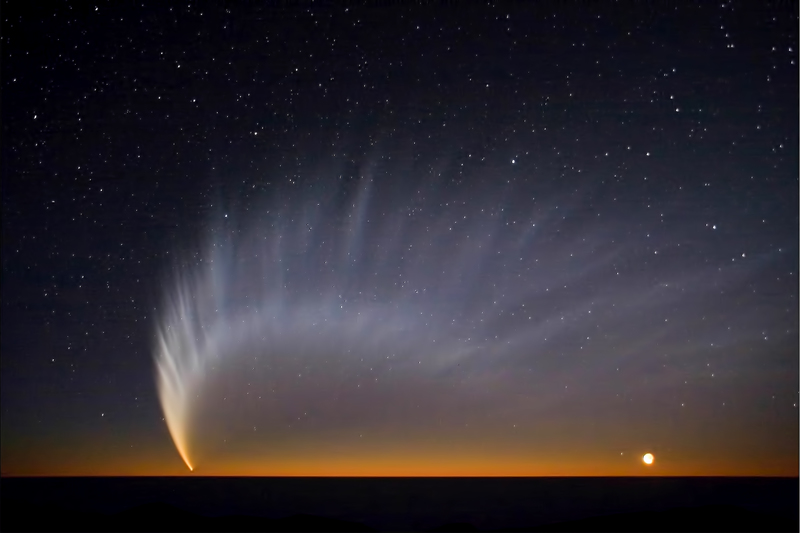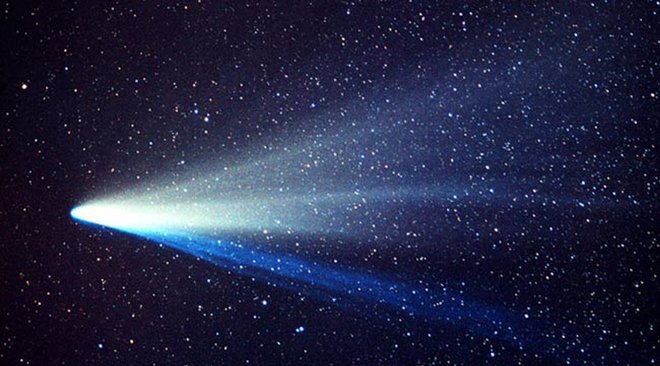Comets
© Charles ChandlerComets have fascinated observers since ancient times. Sometimes visible even during the day, they curiously leave trails that always point away from the Sun. (See Figure 1.)In early modern times, the characteristics of the cometary tails (i.e., the comas) led natural philosophers to the conclusion that the comas are made of material blown off of the comets by some sort of wind emanating from the Sun (hence the birth of the concept of a "solar wind"). But that's a lot of material to lose for such a small object. More tellingly, regular comets (e.g., Halley's Comet) would be quite impossible if they lost that much material during each pass — the mass loss would alter the momentum/friction ratio, which would alter the orbit. Further still, the orbits of comets can be accurately parameterized without having to take into account any gas pressure from the solar wind, which would certainly throw the comet off course, if it were a factor. Finally, data collected from the surface of comets reveal that they are covered with dust finer than talcum powder — before and after perihelion. It wouldn't take much wind to remove a layer of fine dust from the surface of the comets, while a wind speed of 400+ km/s should sweep the surface quite clean.It's possible that the comas are not made of material from the comet at all — rather, the comas might be just an alteration in the plasma through which the comet traversed, which condensed because of the comet. The reason for the condensation might be rather simple. That close to the Sun, the interplanetary medium is mainly monoatomic matter, due to photo-ionization from the extremely powerful solar radiation. But in the shade of the comet, the photo-ionization stops, and the temperature drops dramatically. At cooler temperatures, electron uptake can happen, with the resulting photon emissions.If this is the case, it enables a more accurate description of the so-called "gas ion tails" such as the blue streak in Figure 2. These always point directly away from the Sun, no matter how far they project away from the comet nuclei. If the comet is moving diagonally in the solar wind, particles stripped off of it won't fall in a line pointing at the Sun. So the "gas ion tails" can only be electron uptake enabled by the absence of photo-ionization in the shade of the comet, and in matter that couldn't have possibly come from the comet itself. The dark blue is the dominant emission frequency of molecular oxygen, which is the most abundant element in the solar wind after helium and hydrogen.1 In the "ion tail" it is to be found in CO and O2 molecules.2:29 The light blue strip, between the white and dark blue, is an emission frequency of hydrogen, and usually indicates the formation of water vapor from monoatomic hydrogen & oxygen.The other tails are white, due to a wider variety of chemical combinations, emitting lots of frequencies. These tails are conventionally considered to be dust blown off of the comet, and illuminated by the Sun. But that wouldn't produce splayed tails — they should all fall in the path traced by the comet through the solar wind. It also wouldn't produce "dust" that's transparent — even where the light from the coma nearly saturates the image, we can still see stars in the distance, which wouldn't be possible if all of the luminosity was coming from the ability of the "dust" to absorb and re-emit light — rather, the visibility of the "dust" would be mutually exclusive with the visibility of faint light sources behind it. This means that the luminosity is being generated by the "dust" itself, when photo-ionized matter captures electrons. In other words, it isn't neutral matter that is getting photo-ionized by the sunlight, and then re-emitting the photons on charge recombination — the matter was already photo-ionized, and gets its chance to re-emit photons only when afforded shade from the sunlight, and without obscuring lights sources in the distance.This model also explains the contraction of the coma inside of 1.5~2.0 AU.3 If the coma were formed by outgassing, we'd expect it to increase with proximity to the Sun. Instead, the coma peaks around 1.5~2.0 AU, and contracts nearer the Sun. This is explained as the disappearance of a shadow nearer the Sun, due to the parallax across such a large object. And without the shadow, the matter never gets a chance to get de-ionized, releasing photons in the process.
References
1. Bochsler, P. (2008): Composition of matter in the heliosphere. Proceedings IAU Symposium No. 257 ⇧
2. Jenniskens, P. (2006): Meteor Showers and their Parent Comets. Cambridge University Press ⇧
3. Sekanina, Z. (1966): Nature et Origine des Comètes. Liège: Université de Liège, 145 ⇧












